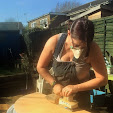Is it just me? Sometimes I write something - an email, a post for this blog, a journal article, a proposal, whatever - and then edit and re-edit, tweak and retweak before sending it off. Some time later, I will have reason to revisit the piece - perhaps because the reader has requested clarification - and my jaw will drop when I see what a scramble I submitted. Am I the only one?
Bear with me. We are going somewhere with this.
Our company's London offices are housed in a beautiful landmark building with great views of the Thames and some wonderful meeting rooms and function spaces.
But today I want to talk about the design of the cloakrooms on the 10th floor. They're unisex, which some people might struggle with, but that's not my beef. The stall I used today has a little hand basin inside, which is great. But then, with dripping hands, I looked around for the means to dry them. Nothing. Just the loo roll, which isn't ideal for the purpose for several reasons. With wet hands, I opened the door, and there was one of those whizzy air blade thingies on the wall outside. Outside.
Um...what...?
It's just a little thing, but it puts me in mind of the basic principles of intuitive design.
When you put your first design proposal (no matter it is that you're designing) in front of the client, they will almost inevitably request changes. And that's fine - that's what the initial design proposal is for. But, once the discussions have been held, and the changes agreed upon, it's important to make sure that the impact of the tweaks and changes don't result in something that makes no sense or serves no purpose or becomes a genuine inconvenience to the user.
When you've been close to the piece from the outset, you're probably not best positioned to notice where the amendments have actually broken it. This is where things like user acceptance testing, or focus groups, or even just the bloke at the next desk become a useful sounding board to make sure that you're still designing something that works.
It's a little thing. But it matters.
Bear with me. We are going somewhere with this.
Our company's London offices are housed in a beautiful landmark building with great views of the Thames and some wonderful meeting rooms and function spaces.
But today I want to talk about the design of the cloakrooms on the 10th floor. They're unisex, which some people might struggle with, but that's not my beef. The stall I used today has a little hand basin inside, which is great. But then, with dripping hands, I looked around for the means to dry them. Nothing. Just the loo roll, which isn't ideal for the purpose for several reasons. With wet hands, I opened the door, and there was one of those whizzy air blade thingies on the wall outside. Outside.
Um...what...?
It's just a little thing, but it puts me in mind of the basic principles of intuitive design.
When you put your first design proposal (no matter it is that you're designing) in front of the client, they will almost inevitably request changes. And that's fine - that's what the initial design proposal is for. But, once the discussions have been held, and the changes agreed upon, it's important to make sure that the impact of the tweaks and changes don't result in something that makes no sense or serves no purpose or becomes a genuine inconvenience to the user.
When you've been close to the piece from the outset, you're probably not best positioned to notice where the amendments have actually broken it. This is where things like user acceptance testing, or focus groups, or even just the bloke at the next desk become a useful sounding board to make sure that you're still designing something that works.
It's a little thing. But it matters.


No comments:
Post a Comment